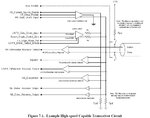2072e
Newbie level 3

Hello there,
I have a 5 meter long inspection camera bought on ebay (**broken link removed**), getting 30 fps @ 640x480. I was measuring the resistance between D+ and D- while connected (DP, DM in the actual image), just for fun, during which the buzzer of multimeter beeped. I'm suspecting that i touched the tips of probes to somewhere else and/or shorted D+ and D-.
Then i plugged it in and now i'm getting 4 fps max. at 320x240 resolution. The resistance between D+ and D- now is ~4.4Kohm. I know it's way too high and it's supposed to be 90ohm.
Well since i don't want to break the camera head, i can't replace the shielded USB cable. So is it gone forever or recoverable for instance with a ferrite bead?

I have a 5 meter long inspection camera bought on ebay (**broken link removed**), getting 30 fps @ 640x480. I was measuring the resistance between D+ and D- while connected (DP, DM in the actual image), just for fun, during which the buzzer of multimeter beeped. I'm suspecting that i touched the tips of probes to somewhere else and/or shorted D+ and D-.
Then i plugged it in and now i'm getting 4 fps max. at 320x240 resolution. The resistance between D+ and D- now is ~4.4Kohm. I know it's way too high and it's supposed to be 90ohm.
Well since i don't want to break the camera head, i can't replace the shielded USB cable. So is it gone forever or recoverable for instance with a ferrite bead?

Last edited by a moderator:

